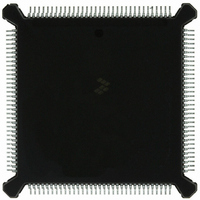MC68332GCEH16 Freescale Semiconductor, MC68332GCEH16 Datasheet - Page 142

MC68332GCEH16
Manufacturer Part Number
MC68332GCEH16
Description
IC MCU 32BIT 16MHZ 132-PQFP
Manufacturer
Freescale Semiconductor
Series
M683xxr
Specifications of MC68332GCEH16
Core Processor
CPU32
Core Size
32-Bit
Speed
16MHz
Connectivity
EBI/EMI, SCI, SPI, UART/USART
Peripherals
POR, PWM, WDT
Number Of I /o
15
Program Memory Type
ROMless
Ram Size
2K x 8
Voltage - Supply (vcc/vdd)
4.5 V ~ 5.5 V
Oscillator Type
Internal
Operating Temperature
-40°C ~ 85°C
Package / Case
132-QFP
Cpu Family
68K/M683xx
Device Core
ColdFire
Device Core Size
32b
Frequency (max)
16MHz
Interface Type
QSPI/SCI/UART
Program Memory Size
Not Required
Total Internal Ram Size
2KB
# I/os (max)
15
Number Of Timers - General Purpose
16
Operating Supply Voltage (typ)
5V
Operating Supply Voltage (max)
5.5V
Operating Supply Voltage (min)
4.5V
Instruction Set Architecture
RISC
Operating Temp Range
-40C to 85C
Operating Temperature Classification
Industrial
Mounting
Surface Mount
Pin Count
132
Package Type
PQFP
Controller Family/series
68K
No. Of I/o's
15
Ram Memory Size
2KB
Cpu Speed
16MHz
No. Of Timers
16
Embedded Interface Type
QSPI, SCI, UART
Digital Ic Case Style
PQFP
Rohs Compliant
Yes
Processor Series
M683xx
Core
CPU32
Data Bus Width
32 bit
Data Ram Size
2 KB
Maximum Clock Frequency
16 MHz
Number Of Programmable I/os
15
Number Of Timers
16
Maximum Operating Temperature
+ 85 C
Mounting Style
SMD/SMT
Minimum Operating Temperature
- 40 C
Lead Free Status / RoHS Status
Lead free / RoHS Compliant
Eeprom Size
-
Program Memory Size
-
Data Converters
-
Lead Free Status / Rohs Status
Compliant
Available stocks
Company
Part Number
Manufacturer
Quantity
Price
Company:
Part Number:
MC68332GCEH16
Manufacturer:
Freescale Semiconductor
Quantity:
10 000
6.3.5.2 Master Wraparound Mode
6.3.5.3 Slave Mode
6-20
When the proper number of bits have been transferred, the QSPI stores the working
queue pointer value in CPTQP, increments the working queue pointer, and loads the
next data for transfer from transmit RAM. The command pointed to by the incremented
working queue pointer is executed next, unless a new value has been written to
NEWQP. If a new queue pointer value is written while a transfer is in progress, that
transfer is completed normally.
When the CONT bit in command RAM is set, PCS pins are continuously driven in
specified states during and between transfers. If the chip-select pattern changes dur-
ing or between transfers, the original pattern is driven until execution of the following
transfer begins. When CONT is cleared, the data in register PORTQS is driven be-
tween transfers.
When the QSPI reaches the end of the queue, it sets the SPIF flag. If the SPIFIE bit
in SPCR2 is set, an interrupt request is generated when SPIF is asserted. At this point,
the QSPI clears SPE and stops unless wraparound mode is enabled.
Wraparound mode is enabled by setting the WREN bit in SPCR2. The queue can wrap
to pointer address $0 or to the address pointed to by NEWQP, depending on the state
of the WRTO bit in SPCR2.
In wraparound mode, the QSPI cycles through the queue continuously, even while the
QSPI is requesting interrupt service. SPE is not cleared when the last command in the
queue is executed. New receive data overwrites previously received data in receive
RAM. Each time the end of the queue is reached, the SPIF flag is set. SPIF is not au-
tomatically reset. If interrupt-driven SPI service is used, the service routine must clear
the SPIF bit to abort the current request. Additional interrupt requests during servicing
can be prevented by clearing SPIFIE, but SPIFIE is buffered. Clearing it does not abort
a current request.
There are two recommended methods of exiting wraparound mode: clearing the
WREN bit or setting the HALT bit in SPCR3. Exiting wraparound mode by clearing
SPE is not recommended, as clearing SPE may abort a serial transfer in progress. The
QSPI sets SPIF, clears SPE, and stops the first time it reaches the end of the queue
after WREN is cleared. After HALT is set, the QSPI finishes the current transfer, then
stops executing commands. After the QSPI stops, SPE can be cleared.
Clearing the MSTR bit in SPCR0 selects slave mode operation. In slave mode, the
QSPI is unable to initiate serial transfers. Transfers are initiated by an external bus
master. Slave mode is typically used on a multi-master SPI bus. Only one device can
be bus master (operate in master mode) at any given time.
Before QSPI operation is initiated, QSM register PQSPAR must be written to assign
necessary pins to the QSPI. The pins necessary for slave mode operation are MISO
and MOSI, SCK, and PCS0/SS. MISO is used for serial data output in slave mode, and
MOSI is used for serial data input. Either or both may be necessary, depending on the
Freescale Semiconductor, Inc.
For More Information On This Product,
QUEUED SERIAL MODULE
Go to: www.freescale.com
USER’S MANUAL
MC68332











